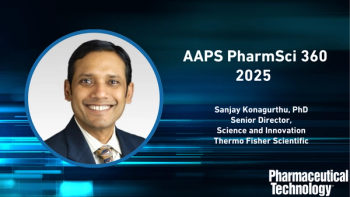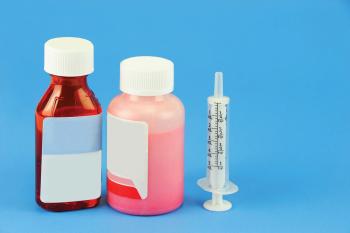
Pharmaceutical Technology Europe
- Pharmaceutical Technology Europe-10-01-2009
- Volume 21
- Issue 10
Defining the ideal properties of a moisture protective, instant release film coating
Applying a moisture protective barrier to tablet cores can help prevent degradation caused by ambient moisture.
Many APIs are moisture-sensitive and thus need protection against ambient moisture. Usually, packaging materials are employed that provide a tight enclosure, but this adds costs to the already expensive manufacturing process. A more cost-effective alternative is to use well-formulated moisture protective coatings that reduce water vapour transmission rate (WVTR).
We investigated polymer characteristics that provide efficient moisture protection and demonstrate— though it may seem contradictory— that adequate reduction of WVTR is possible with film coats based on a water-soluble polymer. For this, we compared the polymer types most often used in moisture protection1 : Hydroxypropyl methylcellulose (HPMC), polyvinyl alcohol (PVA), and Kollicoat Instant Release (IR) combined with PVA (Kollicoat Protect; BASF, Germany).
Stockbyte/Getty Images
Physical characteristics
WVTR can be described using Fick's first law,2 which states that the amount of water vapour diffusing across a film barrier at a given time is a function of the following:
- The moisture gradient, which can be calculated based on the specific water activity of the core formulation and the ambient humidity. Whereas ambient humidity is defined by ICH guidelines (at least for stability studies),3 the water activity of the core is dependent on the excipients present in the core formulation.
- The diffusion constant and the surface area of the tablet.
- The layer thickness of the film.
To prevent free diffusion of water molecules across the film membrane, water-insoluble additives, such as pigments, can be incorporated into the coating formulation.4,5
The effect of this is prolonged diffusion time and distance within the core, which helps protect against moisture. A crucial polymer characteristic for this method of moisture protection is the flexibility of the polymer film; it must allow the incorporation of large amounts of water-insoluble pigments without negatively affecting the film strength and flexibility.
Preparing the polymers
To compare the characteristics of different polymers, we first prepared 20% polymer solutions, which were then cast as films on a Coatmaster (Erichsen, Germany) The cast films were left to acclimatise at 23 °C/50% relative humidity (RH)6 for at least 48 h. Film strips with a 4 mm diameter were cut out using a manual punch, care being taken not to transfer moisture from the fingers to the film.
The cross section of the film was calculated based on the film thickness and width to calculate the strain. A self programmed Excel macro was then used to compute values obtained. The following elongation at break values were obtained for the polymers used: HPMC (3cP-grade: 3%; 6cP-grade: 11%), PVA (226%) and Kollicoat Protect (256%).6
Comparing the WVTR of different polymers
One method of determining the effectiveness of a moisture protective coating is by measuring the WVTR of the polymer films.
Moisture protection formulations based on HPMC, (incorporating stearic acid for moisture protection), PVA and Kollicoat Protect were prepared, and cast directly onto a PVC layer placed on a heatable metal plate. Typically, film coating processes are performed with an inlet air temperature of 50–80 °C resulting in product temperatures of 35–45 °C,6,7 so the cast films were dried at 45 °C.
WVTR of the formulations was measured using a permeation moisture vapour transmission rate tester (Permatran-C model 4/41; Mocon, MN, USA). The results obtained were compared with a classical instant release coating formulation based on HPMC (not containing stearic acid that would reduce WVTR). Figure 1 shows the values obtained for the different moisture barrier formulations.
Figure 1: WVTR of different film coating formulations (23°C/85% RH).
Optimizing the formula
Influence of pigments on WVTR
The formulation based on Kollicoat Protect gave the least WVTR value (less than 90 g/100 µm/m2 day) (Figure 1) and, as such, we continued the study with this polymer, to see the effect of varying pigment concentrations on the WVTR. Talc and iron oxide red were used as pigments in the ratio 9:1.4,8 The results obtained showed that the higher the pigment content of the formulation, the higher the moisture barrier functions of the film (Figure 2).
Figure 2: Dependence of WVTR on the amount of pigments used in the Kollicoat Protect formulation.
The effect of pigment concentration and type on WVTR was investigated, by preparing isolated films of the polymer suspension containing different pigments, and determining their WVTR.4Figure 2 shows that the formulation containing 75% pigment gave the greatest reduction in WVTR.
Further studies however, were performed to assess film flexibility. With a polymer content of 25%, films were found with an elasticity of 1–3%, whereas, higher contents of Kollicoat Protect increased the elasticity of the film to more than 3%. We decided, therefore, to continue our studies with the formulation containing 50% pigment as we found that this gave the best balance between moisture protection and film flexibility (the elongation at break for Kollicoat Protect with a 50:50 ratio was more than 10%).
The 50% polymer suspension was, therefore, selected to assess the effect of pigment shape on WVTR.
Titanium dioxide (TiO2) has a spherical shape with a mean particle size of approximately 1 µm whereas talc is a fibrous mass with a mean particle size of 10–20 µm. The colouring agent — 5% iron oxide red — was added to each formulation. The results obtained (Figure 3) showed no appreciable differences for polymer films containing different pigments. Based on this, we concluded that WVTR is not markedly influenced by the type of insoluble pigment used. This, however, was not always the case for other additives tested.
Figure 3: WVTR as function of type of pigments.
Based on their barrier-enhancing properties,7,9,10 the following additives were tested — Myrj 59, Brij 721, stearic acid, carnauba wax, lecithin, xanthan gum, SDS and Aerosil R 972 (Evonik). Our studies showed that some of the additives (e.g., stearic acid, lipophilic Aerosil) increased film brittleness.4 Therefore, only additives that significantly improve the film's moisture barrier function should be used. In our study, we found that the combination of sodium lauryl sulfate and hydrophobic fumed silica, gave the best WVTR with a reduction of 80%.4
Coating properties
The film coating process was investigated for Kollicoat Protect-, PVA- and HPMC-based protective coatings, using the Process-Parameter-Chart.11 This chart is based on the assumption that adjustable process parameters, such as inlet air temperature, humidity and spray rates, will affect the process time.
The process time calculated using Equation 1 yields values that can be plotted against product temperature measurements. Visual appraisal of the coated core was done and recorded for given time intervals and product temperatures.
On plotting the product temperature against the process time, and assigning colour charts based on the aesthetic quality of the coated core, a frame that is used for process comparison of film coating formulations was developed.
The plotted values were assigned colour codes, based on their degree of acceptability: dark green >light green >orange >red, where dark green is the most acceptable coat quality.
The data in Figures 4–6 were obtained for the film coating of 8.5 kg cores to a weight gain of 3.5%.11 An AccelaCoater 24" (Manesty, UK) with a drum speed of 12 rpm was used. Other coating conditions were:
- Schlick ABC nozzle with a bore size of 1.0 mm
- Spray pressure of 2 bar and a flat jet air pressure of 1 bar
- Exhaust air quantity of 425 m3 /h.
Figures 4 and 5 shows the similarity in the Process-Parameter-Chart obtained for both Kollicoat Protect and the PVA formulations. The dark green area indicates the process temperatures and times within which an aesthetically good film coat was obtained. By maintaining a product temperature of approximately 40 °C, a process time of 50 min would fall within this region (dark green zone).
Figure 4: Process-Parameter-Chart of the Kollicoat Protect based protective coating.
The fact that the dark green area in the process chart allows a large window of applicable parameters, means that scale-up operations can be easily achieved.11
Figure 5: Process-Parameter-Chart of the PVA based protective coating.
The picture is decidedly different for the HPMC-based protective coating. The smaller dark green area indicates a narrower product temperature window (25–32 µC), which is achieved under a comparatively longer process time >80 min (Figure 6).
Figure 6: Process-Parameter-Chart of the HPMC based protective coating.
In conclusion
According to our studies, Kollicoat Protect and the PVA-based coating formulation gave the highest moisture barrier protection of the polymers tested. Both polymer types showed high pigment binding capacity, as well as a wider window of applicable parameters, which is an advantage for scale-up activities.
The author says...
Thorsten Cech is manager of the European Pharma Application Lab at BASF.
Maureen Mistry is a Technical Service Manager at BASF Pharma Ingredients & Services Europe.
References
1. J. Bley, J. Siepmann and R. Bodmeier, Int. J. Pharm., 378, 59–65 (2009).
2. S. Yoon, D. Sparks and S. Selke, Pharmacopeial Forum, 35(2), 488–492 (2009).
3. European Medicines Agency (EMEA) — Stability Testing of new Drug Substances and Products, Note for Guidance on Stability Testing: Stability Testing of New Drug Substances and Products, August 2003.
4. T. Agnese and T. Cech, "Developing an Instant release Moisture Protective Coating Formulation based on Kollicoat Protect as Film Forming Polymer," PBP World Meeting (Barcelona, Spain, 7–10 April 2008). www.pharma-solutions.basf.de
5. T.Cech and K.Kolter, "Influence of plasticisers on the film properties of HPMC, and PVA and comparison of the properties of Kollicoat IR as a single film former," Excipient fest Europe (Cork, Ireland, 17–18 June 2008).
6. G. Cole, J. Hogan and M. Aulton, Pharmaceutical Coating Technology, p 199, Taylor & Francis, London, UK (2001).
7. ASTM F-1249 06 Standard Test Method for Water Vapor Transmission Rate Through Plastic Film and Sheeting Using a Modulated Infrared Sensor.
8. M.G. Ageeva and E.N. Lazareva, Pharm. Chem. J., 2(10), 582–585 (1968).
9. L.L. Augsburger and Stephen W. Hoag (Third edition, Volume 1), Pharmaceutical Dosage Forms: Tablets (Healthcare USA, Inc. 2008) p 402.
10. T. Cech and K. Kolter, Comparison of the Coating Properties of Instant Release Film Coating Materials Using a Newly Developed Test Method – the Process-Parameter-Chart; PSWC (2007).
Articles in this issue
about 16 years ago
A new tool to battle counterfeitsabout 16 years ago
MRT coming soon to a plant near youabout 16 years ago
The rise of in silico R&Dabout 16 years ago
Removing endotoxin from biopharmaceutical solutionsabout 16 years ago
How to manage the threat of the global supply chain and save moneyabout 16 years ago
Microreactor technology: Is the industry ready for it yet?about 16 years ago
Is all sunny in Spanish pharma?about 16 years ago
NewsNewsletter
Get the essential updates shaping the future of pharma manufacturing and compliance—subscribe today to Pharmaceutical Technology and never miss a breakthrough.




